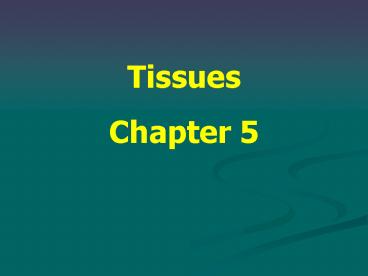Tissues - PowerPoint PPT Presentation
1 / 44
Title:
Tissues
Description:
Title: Slide 1 Author: Thielh Last modified by: Thielh Created Date: 9/25/2006 6:27:53 PM Document presentation format: On-screen Show Company: Edon Northwest Local ... – PowerPoint PPT presentation
Number of Views:15
Avg rating:3.0/5.0
Title: Tissues
1
Tissues Chapter 5
2
Connective Tissues -Found throughout the body
-Most abundant type of
tissue by weight -Binds together,
provides support
3
-It fills spaces, stores fat, produces blood
cells -Helps repair tissue and fights infection
4
- Major Types of Cells in Connective Tissue
- Resident Cells
- -Usually present in stable numbers
5
2 Ex. of resident cells Fibro Blasts-most
common, produce fibers that help make connective
tissue
6
Mast Cells -Usually located near blood vessels
-Not truly understood
7
-Help prevent blood clotting -Release histamine,
promotes reactions associated with inflammation
allergies
8
2) Wandering Cells Usually appear temporarily in
tissues normally in response to an injury or
infection
9
Macrophage -Can be either resident or wandering
cells
10
Connective Tissue Fibers 3 Types of fibers
produced by fibroblasts
11
- Collagenous
- -Thick threadlike parts composed of the protein
collagen - When abundant is called Dense Connective Tissue
12
-Grouped in long parallel bundles -Flexible but
only slightly elastic -Have great tensile
strength
13
(capable of resisting considerable pulling
force) -Important part of tendons (connect
muscle to bone)
14
2) Elastic -Branched
network formed from the protein Elastin
-Common in parts that are
stretched and can return to original shape/length
15
-Common in parts that are stretched (vocal
cords)
16
3) Reticular -Composed of collagen -Support a
variety of tissue
17
Loose Connective Tissue -Forms delicate, thin
membrane throughout the body
18
-Cells of this tissue are mostly
fibroblasts -Binds the skin to underlying organs
and fills spaces between muscles
19
Adipose Tissue -A.K.A. fat -Specialized form of
loose connective tissue -Stores fat droplets
20
-Found beneath the skin and between
muscles -Around kidneys, eyes, heart, joints
21
-Protective cushion for joints organs
-Insulator
22
Fibrous Connective Tissue -Contains many closely
packed, thick collagenous and elastic fibers
23
-Relatively few cells -Binds body parts together
tendonsmuscle to bone, ligamentsbone to bone
24
-Blood supply is low slow to repair
25
Cartilage -Very rigid connective tissue
-Supports parts, provides
framework and attachments for underlying tissues
26
Cartilage Cells Chondrocytes 3 Types of
Cartilage
27
- Hyaline -Most common
-Looks milky white -Occurs at
the ends of bones
-Found in many joints and soft part of nose
28
2) Elastic -Very flexible -Provides framework for
external ears and larynx
29
3) Fibrocartilage -Tough tissue -Contains a lot
of collagen -Serves as shock absorber (back,
knees, hips, ankles)
30
Bone -Rigid connective tissue -Hardness due to
the pressure of mineral salts
31
-Contains great amount of collagen in its
fibers -Provides internal support for
body -Serves as attachments for muscles
32
-Function in forming blood cells -Bone cells
osteocytes (arranged in connective circles)
33
Other Connective Tissues Blood-vascular
tissue -Transports nutrients and a variety of
substances between body cells and the external
environment
34
-Blood is composed of cells that are suspended in
a fluid called blood plasma (ex. red blood cells
RBCs, white blood cells WBCs, platelets)
35
-Helps to maintain a stable internal
environment -Most blood cells are formed in red
marrow of certain hollow bones
36
Muscle Tissue -Its Contractile (muscle fibers
change shape by becoming shorter and thicker)
37
-As they contract, they pull their attachment
ends and cause the body part to move
38
- 3 Types of Muscle Tissue
- Skeletal
- -They have striations
- -Found in muscles that are attached to bones
39
-Can be controlled by conscious effort
(voluntary) -Responsible for moving head, trunk,
and limbs
40
2) Smooth -Lack striations -Found in
walls of hollow organs (stomach, intestines,
urinary bladder, uterus, blood vessels)
41
-Cant be controlled (involuntary) 3)
Cardiac -Cells are striated, jointed end to
end -Only found in heart
42
-Involuntary Nervous Tissue -Found in the brain,
spinal cord, and peripheral nerves -Nerve cells
Neurons
43
Neurons are sensitive to changes and respond by
transmitting nerve impulses along nerve fibers
(muscles or glands)
44
-Nerve cells are the longest cells in the
body -Neuroglial Cells-Along with neurons support
and bind the components of nervous tissue together































